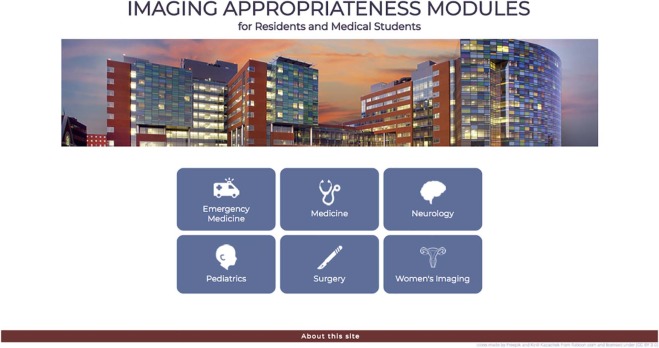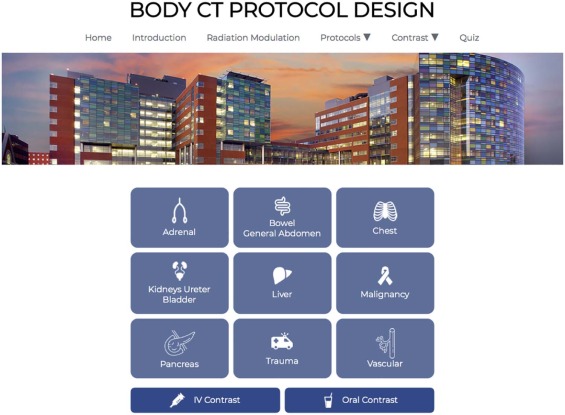Rationale and Objectives
The role of a radiologist has expanded beyond the tripartite mission of patient care, education, and research to include cross-specialty consultation for patient management, innovative solutions to improve health-care quality and safety, device design, and policy advocacy. As such, radiology residency programs should incorporate formalized training to prepare residents for these various professional roles.
Materials and Methods
Since the 2015–2016 academic year, five training tracks focused on noninterpretative skills have been integrated into our residency training program: Clinician Educator, Quality Improvement, Entrepreneurship/Innovation, Health Policy Advocacy, and High-Value Care. Each track is longitudinal, with a set of requirements throughout the residents’ training necessary to achieve certification at graduation.
Results
To date nine residents have participated in the programs, including two who received distinction in two separate tracks. Residents in each of the tracks have implemented successful initiatives related to the focus area. As such, these tracks enrich training by ensuring that residents make meaningful contributions to the department and institution during their training and disseminate successful initiatives through presentation at national meetings and publications.
Conclusion
The duration of a radiology residency and resources available in an academic center provide opportunities for residency program directors to advance residents’ skills in important noninterpretative components of radiology practice. Regardless of whether residents pursue academic medicine or private practice, these skills are necessary for graduates to become valuable members of a radiology practice and serve as national leaders in the field of radiology.
Introduction
The role of a radiologist involves more than the interpretation of images; radiologists also act as educators, policy advisors, consultants, inventors, and quality improvement leaders. To prepare for these various roles radiologists will likely undertake in their professional careers, it is valuable for diagnostic radiology residency programs to offer learning opportunities in these areas during training. Indeed, one of the overarching goals of Accreditation Council for Graduate Medical Education (ACGME) training is to create a foundation for professional growth. The ACGME also cites several specific noninterpretative skills in its “Core Competencies” of diagnostic radiology residency, including quality improvement, participation in education, acting as a consultant, and supporting improved patient care (ACGME) .
Our residency has a long-standing research track, with the opportunity to complete a full year of funded research through a departmental T32 grant. Other institutions have reported on novel programs to encourage career development in important noninterpretative areas of professional development including teaching (to prepare residents for academic careers); entrepreneurship (to train and encourage residents to create new devices and technologies); health-care policy (to educate residents on issues related to the health-care system and develop leadership skills in this area); and quality improvement .
Get Radiology Tree app to read full this article<
Methods and Results
Get Radiology Tree app to read full this article<
Get Radiology Tree app to read full this article<
Clinician Educator Track
Get Radiology Tree app to read full this article<
Get Radiology Tree app to read full this article<
Quality Improvement Track
Get Radiology Tree app to read full this article<
Get Radiology Tree app to read full this article<
Get Radiology Tree app to read full this article<
Entrepreneur/Innovator Track
Get Radiology Tree app to read full this article<
Get Radiology Tree app to read full this article<
Health-care Policy Track
Get Radiology Tree app to read full this article<
Get Radiology Tree app to read full this article<
High-value Health-care Track
Get Radiology Tree app to read full this article<
Get Radiology Tree app to read full this article<
Get Radiology Tree app to read full this article<
Outcomes
Get Radiology Tree app to read full this article<
TABLE 1
Special Distinction Tracks Completed in the Past 2 Years with Two Residents Achieving Distinction in Two Separate Pathways
Special Distinction Track 2016 2017 Clinician educator 1 2 Health policy 1 2 Quality improvement 1 2 Innovator 1 Health-care value 1
Get Radiology Tree app to read full this article<
Get Radiology Tree app to read full this article<
Get Radiology Tree app to read full this article<
Get Radiology Tree app to read full this article<
Get Radiology Tree app to read full this article<
Conclusion
Get Radiology Tree app to read full this article<
Get Radiology Tree app to read full this article<
References
1. Accreditation Council for Graduate Medical Education (ACGME). : Program requirements for graduate medical education in diagnostic radiology. Available at https://www.acgme.org/Portals/0/PFAssets/ProgramRequirements/420_diagnostic_radiology_2017-07-01.pdf
2. Webb E., Ahearn B., Naeger D.M.: A designated “Teaching Resident”: A novel leadership position to promote educational skills and an academic career. J Am Coll Radiol 2015; 13: pp. 77-80.
3. Naeger D.M., Phelps A., Shah V., et. al.: Clinician-educator pathway for radiology residents. Acad Radiol 2011; 18: pp. 6404.
4. Donnelly E.F.: A leadership development curriculum for radiology residency. J Grad Med Educ 2015; 7: pp. 296-297.
5. DeQuesada I.M., Chokshi F.H., Mullins M.E., et. al.: Practice management and health policy education in radiology: an emerging imperative. J Am Coll Radiol 2015; 12: pp. 1085-1092.
6. ACR Fellowships : American College of Radiology Fellowships. Available at https://www.acr.org/Member-Resources/rfs/fellowships
7. Radiology Leadership Institute : American College of Radiology. Available at https://www.radiologyleaders.org/meetings-and-courses/live-meetings/2018-annual-event-scholarship-policies
8. Nguyen M.L., Porter K., Johnson P.T.: Mastering the ACGME medical knowledge milestone for Body CT and MR protocol selection and optimization of images: a training module for radiology residents.64th Association of University Radiologists Annual Meeting.2016. San Diego, CA
9. Trakhtenbroit M., Abdollahian D., Horton K.M., et. al.: Choosing wisely and imaging 3.0 professional development: radiology resident consultant service. J Am Coll Radiol 2016; 13: pp. 730-732.
10. Abdollahian D., Nagy P.: Quality and safety as the spark for employee engagement. J Am Coll Radiol 2014; 11: pp. 209-211.
11. Owens A., Abdollahian D., Dawson M., et. al.: IR patient throughput: applying lean sigma methodology to reduce procedure room downtime. Soc Interv Radiol Meet 2016; 27: pp. S144.
12. Jensen J.D., Durand D.J.: Partnering with your health system to select and implement clinical decision support for imaging. J Am Coll Radiol 2017; 14: pp. 262-268.
13. Jensen J.D., Allen L., Blasko R., et. al.: Using quality improvement methods to improve patient experience. J Am Coll Radiol 2016; 13: pp. 1550-1554.
14. Narayan A., Trimble C., Seeburg D., et. al.: Fostering longitudinal involvement in state chapter resident and fellow sections: the Maryland experience. J Am Coll Radiol 2016; 13: pp. 598-600.
15. Nguyen M.L., Minwell G., Sujlana P., et. al.: Radiology professional development: Creation of a leadership and advocacy pathway.2017.American College of Radiology ConferenceWashington, DC

